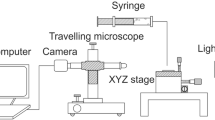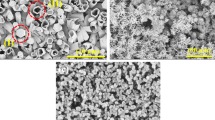Abstract
In this paper, the biomimetic lotus leaf films of ZnO were fabricated by the two-step method of UV imprint and hydrothermal growth. First, the photoresist micropapillae film was prepared by UV imprint technique from a natural lotus leaf. Then the hydrothermal growth method was used to grow ZnO nanowires (NWs) on the surface of the photoresist micropapillae film and obtained the biomimetic lotus leaf films of ZnO. ZnO NWs with high aspect ratio were obtained by changing the concentrations of growth solution and the assistance of additives. Different methods including SEM、TEM、XRD and XPS were used to characterize the surface structure and chemical properties of the films. Results show that the films have significant micro-nano hierarchical structures, which the ZnO NWs are arranged uniformly. The superhydrophobic and self-cleaning properties of the ZnO films were also investigated, and the water contact angle and sliding angle of the films can respectively reach 156° and 9.6°. Thus, it is a simple and low cost process to fabricate biomimetic lotus leaf films of ZnO with superhydrophobic properties by the two-step method. The prepared ZnO films have potential application prospects in photovoltaic energy, medical, military and other fields.
Graphical abstract

The biomimetic lotus leaf films of ZnO fabricated by the two-step method of UV imprint and hydrothermal growth have excellent superhydrophobic and self-cleaning properties. The biomimetic lotus leaf films of ZnO were fabricated by the two-step method of UV imprint and hydrothermal growth. We have discussed the influence of the concentration of the hydrothermal growth solution on the diameter, length, and density of the ZnO NWs. Different methods including SEM, TEM, XRD and XPS have been used to characterize the morphology and structural properties of the ZnO films. Results show that the films have significant micro-nano hierarchical structures, which the ZnO NWs are arranged uniformly. Also, the superhydrophobic and self-cleaning properties of the prepared biomimetic lotus leaf film of ZnO have been studied, which indicates that the films have excellent superhydrophobic and self-cleaning properties. Thus, it is a simple and low-cost process to fabricate biomimetic lotus leaf films of ZnO with superhydrophobic property using natural lotus leaf as raw material by two-step method. The prepared ZnO films have potential application prospects in photovoltaic energy, medical, military and other fields.
Highlights
-
The biomimetic lotus leaf films of ZnO were fabricated by the two-step method of UV imprint and hydrothermal growth.
-
Influence of the concentrations of growth solution and the assistance of additives was discussed.
-
The obtained ZnO films have a three-dimensional micro-nano composite structure.
-
The obtained ZnO films exhibit excellent superhydrophobicity and self-cleaning ability.










Similar content being viewed by others
References
Latthe SS, Sutar RS, Kodag VS, Bhosale AK, Kumar AM, Kumar Sadasivuni K, Liu S (2019) Self-cleaning superhydrophobic coatings: Potential industrial applications. Prog Org Coat 128:52–58
Liu G, Zhang PF, Liu Y, Zhang DY, Chen HW (2018) Self-lubricanting slippery surface with wettability gradients for anti-sticking of electrosurgical scalpel. Micromachines 9:591
Yoon JS, Ryu M, Kim H, Ahn G, Yim S, Kim D, Lee H (2020) Wet‐Style Superhydrophobic Antifogging Coatings for Optical Sensors. Adv Mater 32:2002710
Shen YZ, Wu ZW, Tao J, Jia Z, Chen H, Liu S, Jiang J, Wang Z (2020) Spraying preparation of eco-friendly superhydrophobic coatings with ultra-low water adhesion for effective anti-corrosion and anti-pollution. ACS Appl Mater Interfaces 12:25484–25493
Wang L, Gong Q, Zhan S, Jiang L, Zheng Y (2016) Robust anti‐icing performance of a flexible superhydrophobic surface. Adv Mater 28:7729–7735
Chehrghani MM, Abbasiasl T, Sadaghiani AK, Kosar A (2021) Copper-Based Superhydrophobic Nanostructures for Heat Transfer in Flow Condensation. ACS Appl Nano Mater 4:1719–1732
Hwang GB, Patir A, Page K, Lu Y, Allan E, Parkin IP (2017) Buoyancy increase and drag-reduction through a simple superhydrophobic coating. Nanoscale 9:7588–7594
Savio L, Bhavitha KB, Bracco G, Luciano G, Cavallo D, Paolini G, Passaglia S, Carraro G, Vattuone L, Masini R, Smerieri M (2021) Correlating hydrophobicity to surface chemistry of microstructured aluminium surfaces. Appl Surf Sci 542:148574
Jiang ZL, Fang SY, Wang CS, Wang HP, Ji CC (2016) Durable polyorganosiloxane superhydrophobic films with a hierarchical structure by sol-gel and heat treatment method. Appl Surf Sci 390:993–1001
Jin MM, Shen YZ, Luo XY, Tao J, Xie YH, Chen HF, Wu Y (2018) A combination structure of microblock and nanohair fabricated by chemical etching for excellent water repellency and icephobicity. Appl Surf Sci 455:883–890
Nedilko SG, Revo S, Chornii V, Scherbatskyi V, Ivanenko K, Nedielko M, Sementsov Y, Skoryk M, Nikolenko A, Strelchuk V (2017) Structure and Optical Features of Micro/Nanosized Carbon Forms Prepared by Electrochemical Exfoliation. Nanoscale Res Lett 12:28
Lin BC, Ku CS, Lee HY, Wu AT (2017) Epitaxial growth of ZnO nanorod arrays via a self-assembled microspheres lithography. Appl Surf Sci 414:212–217
Guo XJ, Xue CH, Sathasivam S, Page K, He G, Guo J, Promdet P, Heale FL, Carmalt CJ, Parkin IP (2019) Fabrication of Robust Superhydrophobic Surfaces via Aerosol-Assisted CVD and Thermo-Triggered Healing of Superhydrophobicity by Recovery of Roughening Structures. J Mater Chem 7:17604–17612
Maver K, Arčon I, Fanetti M, Jitan SA, Palmisano G, Valant M, Lavrenčič Štangar U (2021) Improved photocatalytic activity of SnO2-TiO2 nanocomposite thin films prepared by low-temperature sol-gel method. Catal Today 397-399:540–549
Zheng J, Yang R, Xie L, Qu JL, Liu Y, Li XG (2010) Plasma-assisted approaches in inorganic nanostructure fabrication. Adv Mater 22:1451–1473
Ruidas S, Das A, Kumar S, Dalapati S, Manna U, Bhaumik A (2022) Non-Fluorinated and Robust Superhydrophobic Modification on Covalent Organic Framework for Crude-Oil-in-Water Emulsion Separation. Angew Chem 61(41):e202210507
Kumar A, Gogoi B (2018) Development of durable self-cleaning superhydrophobic coatings for aluminium surfaces via chemical etching method. Tribol Int 122:114–118
Vilaró I, Yagüe JL, Borrós S (2016) Superhydrophobic Copper Surfaces with Anticorrosion Properties Fabricated by Solventless CVD Methods. ACS Appl Mater Interfaces 9:1057–1065
Dong F, Ding W, Wang JD (2019) Interfacial tension gradient driven self-assembly of binary colloidal particles for fabrication of superhydrophobic porous films. J Colloid Interface Sci 548:312–321
Xie H, Huang HX, Peng YJ (2017) Rapid fabrication of bio-inspired nanostructure with hydrophobicity and antireflectivity on polystyrene surface replicating from cicada wings. Nanoscale 9:11951–11958
Huang L, Duan Y, Dai X, Zeng Y, Ma G, Liu Y, Gao S, Zhang W (2019) Bioinspired Metamaterials: Multibands Electromagnetic Wave Adaptability and Hydrophobic Characteristics. Small 15:1902730
Kumar M, Bhardwaj R (2020) Wetting characteristics of Colocasia esculenta (Taro) leaf and a bioinspired surface thereof. Sci Rep. 10:935
Yun XW, Xiong ZY, He YN, Wang XG (2020) Superhydrophobic lotus-leaf-like surface made from reduced graphene oxide through soft-lithographic duplication. RSC Adv 10:5478–5486
Shao YL, Zhao J, Fan Y, Wan ZP, Lu LS, Zhang ZH, Ming WH, Ren LQ (2019) Shape Memory Superhydrophobic Surface with Switchable Transition between “Lotus Effect” to “Rose Petal Effect. Chem Eng J 382:122989
Gou XL, Guo ZG (2019) The superhydrophobic plant leaves: The variation in surface morphologies and wettability during the vegetation period. Langmuir 35:1047–1053
Yamamoto M, Nishikawa N, Mayama H, Nonomura Y, Yokojima S, Nakamura S, Uchida K (2015) Theoretical Explanation of the Lotus Effect: Superhydrophobic Property Changes by Removal of Nanostructures from the Surface of a Lotus Leaf. Langmuir 31:7355–7363
Wang FP, Li S, Wang L (2017) Fabrication of artificial super-hydrophobic lotus-leaf-like bamboo surfaces through soft lithography. Colloids Surf A: Physicochem Eng Asp 513:389–395
Hu J, Sun YJ, Zhang WD, Gao FQ, Li PW, Jiang D, Chen Y (2014) Fabrication of hierarchical structures with ZnO nanowires on micropillars by UV soft imprinting and hydrothermal growth for a controlled morphology and wettability. Appl Surf Sci 317:545–551
Syrrokostas G, Govatsi K, Yannopoulos SN (2016) High-Quality, Reproducible ZnO Nanowire Arrays Obtained by a Multiparameter Optimization of Chemical Bath Deposition Growth. Cryst Growth Des 16:2140–2150
Pawar SA, Devan RS, Patil DS, Burungale VV, Bhat TS, Mali SS, Shin SW, Ae JE, Hong CK, Ma YR, Kim JH, Patil PS (2014) Hydrothermal growth of photoelectrochemically active titanium dioxide cauliflower-like nanostructures. Electrochim Acta 117:470–479
Clemente A, Moreno N, Lobera MP, Balas F, Santamaria J (2018) Versatile hollow fluorescent metal-silica nanohybrids through a modified microemulsion synthesis route. J Colloid Interface Sci 513:497–504
Dang H, Qiu Y, Cheng Z, Yang W, Wu H, Fan H, Dong X (2016) Hydrothermal preparation and characterization of nanostructured CNTs/ZnFe2O4 composites for solar water splitting application. Ceram Int 42:10520–10525
Lopes LF, Pontes FM, Garcia LO, Pontes DSL, Padovani D, Chiquito AJ, Teixeira SR, Colmenares YN, Mastelaro VR, Longo E (2018) Silver-controlled evolution of morphological, structural, and optical properties of three-dimensional hierarchical WO3 structures synthesized from hydrothermal method. J Alloy Compd 736:143–151
Liu Y, Yang L, Shen Y (2018) Hydrothermal synthesis of gold nanoplates and their structure-dependent LSPR properties. J Mater Res 33:2671–2679
Król A, Pomastowski P, Rafińska K, Railean-Plugaru V, Buszewski B (2017) Zinc oxide nanoparticles: Synthesis, antiseptic activity and toxicity mechanism. Adv Colloid Interface Sci 249:37–52
Choi YJ, Gong SC, Kang KM, Park HH (2014) Enhanced hole injection into indium-free organic red light-emitting diodes by fluorine-doping-induced texturing of a zinc oxide surface. J Mater Chem C 2:8344–8349
GuruSampath Kumar A, Li XJ, Du Y, Geng YF, Hong XM (2019) UV-photodetector based on heterostructured ZnO/(Ga,Ag)-co-doped ZnO nanorods by cost-effective two-step process. Appl Surf Sci 509:144770
Jeon IS, Bae G, Jang M, Yoon Y, Jang S, Song W, Myung S, Lim JS, Lee SS, Jung HK, Hwang JH, An KS (2021) Atomic-level mediation in structural interparameter tradeoff of zinc oxide nanowires-based gas sensors: ZnO nanofilm/ZnO nanowire homojunction array. Appl Surf Sci 540:148350
Pietruszka R, Witkowski BS, Gieraltowska S, Caban P, Wachnicki L, Zielony E, Gwozdz K, Bieganski P, Placzek-Popko E, Godlewski M (2015) New efficient solar cell structures based on zinc oxide nanorods. Sol Energy Mater Sol Cells 143:99–104
Chandra D, Mridha S, Basak D, Bhaumik A (2009) Template directed synthesis of mesoporous ZnO having high porosity and enhanced optoelectronic properties. Chem Commun 17:2384–2386
Bhanja P, Bhunia K, Das SK, Pradhan D, Kimura R, Hijikata Y, Irle S, Bhaumik A (2017) A New Triazine-Based Covalent Organic Framework for High-Performance Capacitive Energy Storage. ChemSusChem 10(5):921–929
Gomes R, Bhaumik A (2016) A new triazine functionalized luminescent covalent organic framework for nitroaromatic sensing and CO2 storage. RSC Adv 6:28047–28054
Liu LQ, Hong KQ, Ge X, Liu DM, Xu MX (2014) Controllable and Rapid Synthesis of Long ZnO Nanowire Arrays for Dye-Sensitized Solar Cells. J Phys Chem C 118:15551–15555
Ameen S, Akhtar MS, Kim YS, Yang OB, Shin HS (2011) Influence of seed layer treatment on low temperature grown ZnO nanotubes: Performances in dye sensitized solar cells. Electrochim Acta 56:1111–1116
Chatterjee S, Bhanja P, Ghosh D, Kumar P, Kanti Das S, Dalapati S, Bhaumik A (2020) Metformin-emplated Nanoporous ZnO and Covalent Organic Framework Heterojunction Photoanode for Photoelectrochemical Water Oxidation. ChemSusChem 14(1):408–416
Pan R, Cai MY, Liu WJ, Luo X, Chen CH, Zhang HJ, Zhong ML (2019) Extremely High Cassie-Baxter State Stability of Superhydrophobic Surfaces via Precisely Tunable Dual-Scale and Triple-Scale Micro-Nano structure. J Mater Chem A 7:18050–18062
Acknowledgements
This work was supported by the National Natural Science Foundation of China (NSFC) (grant numbers: 61605086, 51602160, 61574080, 61274121). Natural Science Basic Research Plan in Shaanxi Province of China (Program No. 2019JM-520).
Author information
Authors and Affiliations
Corresponding authors
Ethics declarations
Conflict of interest
The authors declare no competing interests.
Additional information
Publisher’s note Springer Nature remains neutral with regard to jurisdictional claims in published maps and institutional affiliations.
Rights and permissions
Springer Nature or its licensor (e.g. a society or other partner) holds exclusive rights to this article under a publishing agreement with the author(s) or other rightsholder(s); author self-archiving of the accepted manuscript version of this article is solely governed by the terms of such publishing agreement and applicable law.
About this article
Cite this article
Zhang, X., Wang, Z., Liu, S. et al. Fabrication of biomimetic lotus leaf film of ZnO by a two-step method of nanoimprint and hydrothermal growth for superhydrophobic applications. J Sol-Gel Sci Technol 108, 73–83 (2023). https://doi.org/10.1007/s10971-023-06162-2
Received:
Accepted:
Published:
Issue Date:
DOI: https://doi.org/10.1007/s10971-023-06162-2




